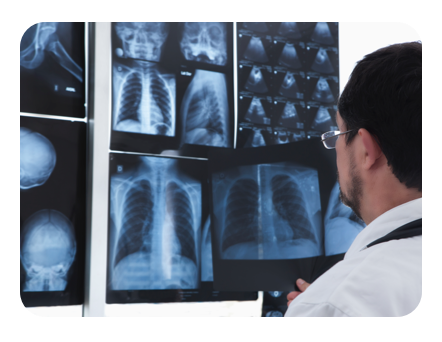Some test results may impact your treatment options.
Biomarker testing is recommended for all patients with advanced-stage lung adenocarcinoma.
Find out if biomarker testing may be right for you
Lung cancer is a type of cancer that starts in the lungs.
There are two main types: non-small cell lung cancer and small cell lung cancer.
The information on this page may help you gain a better understanding of the most common type of lung cancer, non-small cell lung cancer. This may help when making important decisions with your doctor.
From Harvard Health Publishing

Lung cancer is one of the world’s most frequently diagnosed types of cancer and the number one cause of cancer-related deaths worldwide; more people die from lung cancer than from breast, colon, and prostate cancer combined.
With so many people diagnosed with this type of cancer, there is a large community of people who can share their stories, offer support, and advocate for each other.
It has a reputation as being a smoker’s disease, and yes, smoking is a major risk factor. But the truth is that 10 to 20 percent of individuals with lung cancer have never smoked.
So, regardless of your smoking history or current smoking status, it’s important to stay aware of lung cancer.
There are two main categories of lung cancer:
The most common type is non-small cell lung cancer (NSCLC). The other, less common form is called small cell lung cancer (SCLC).
Though non-small cell lung cancer progresses more slowly than small cell lung cancer, 70% of NSCLCs will have spread beyond the lungs by the time it is diagnosed.

The most common type of lung cancer is non-small cell lung cancer (NSCLC), named for how the cancer cells look when viewed under a microscope. About 85 percent of all lung cancers are NSCLC.
Most non-small cell lung cancer starts in the tissue lining the surface of the lungs, usually in the cells that line the bronchi (the tubes that connect the trachea, or windpipe, with the lungs), bronchioles (the smaller airways that branch throughout the lungs), or alveoli (the tiny air sacs at the end of the bronchioles).
There are three main types of NSCLC. Your doctor will determine which one you have by viewing a sample of your cancer cells under a microscope.
Of the three main types of NSCLC (adenocarcinoma, squamous cell carcinoma, and large cell carcinoma), squamous cell carcinoma and large cell carcinoma are more likely to have spread when they are first diagnosed.
This is the most common type of NSCLC, accounting for approximately 40% of these cancers. Adenocarcinomas usually begin in the outer areas of the lung, in the mucus-producing cells that line the small airways, called bronchioles. These cancers tend to begin in the bronchioles and alveoli, located in the outer edges of the lungs. They are diagnosed in smokers as well as non-smokers. In fact, they are the most common NSCLC found in non-smokers. When NSCLC is diagnosed in a younger person, it’s usually an adenocarcinoma.
This is the second most commonly diagnosed form of NSCLC, causing between 25 and 30 percent of NSCLC. Squamous cell carcinomas usually start in the center of the lung near the right or left bronchus, and the name comes from the flat, thin squamous cells in which the cancer usually starts. Smokers are most likely to be diagnosed with this type of NSCLC, and it is more likely to spread to other parts of the body compared to adenocarcinomas. Squamous cell carcinoma is sometimes referred to as epidermoid carcinoma.
About 10 to 15% of NSCLCs are large cell carcinomas that can appear anywhere in the lung. It tends to spread more quickly than squamous cell carcinoma or adenocarcinoma.
NSCLC tends to grow and spread more slowly than the other main type of lung cancer, small cell lung cancer. Still, about 70% of patients with NSCLC will see their lung cancer spread by the time they are diagnosed.
The most common sites where NSCLC spreads to are the:
When NSCLC has spread beyond the lungs to any of these sites, it is called metastatic NSCLC. And even though it is now in a different body part, it’s still considered lung cancer. For example, lung cancer that spreads to the brain is not considered brain cancer; it’s metastatic lung cancer. Similarly, cancer that starts in another part of the body – the breast, for instance – and spreads to the lung is not considered lung cancer but metastatic breast cancer.

Biomarker testing is recommended for all patients with advanced-stage lung adenocarcinoma.
Find out if biomarker testing may be right for you
Staging is an important step in any patient’s lung cancer journey and is used to help decide what treatment or treatments will be used to fight your cancer. It is a way of describing how advanced the cancer is and whether or not it has spread to other organs.
Staging also helps the doctor determine your prognosis, which describes the chances that your cancer may or may not return.
Cancer diagnosed at an earlier stage may have a better prognosis because it has not spread while advanced cancer may present additional challenges.
There are five stages of cancer, Stage 0 through Stage 4. In general, the higher the number, the more the cancer has spread.
A diagnosis of Stage 0 NSCLC means abnormal cells have been found in the lining of the airways. These abnormal cells are not considered to be cancer but could become cancerous and spread into other lung tissue. Stage 0 cancer is also called carcinoma in situ. In situ is Latin for “in position,” which describes a cancer that is only present in the cells where it started and has not spread to any other tissue.
Stage 1 NSCLC is when there is a small tumor that has not spread to the lymph nodes or other parts of the body. Stage 1 NSCLC is divided into two substages, based primarily on the size of the tumor:
Stage 2 NSCLC is also divided into two substages:
Stage 3 NSCLC has not spread to distant parts of the body but has reached the lymph nodes in the center of the chest (which is outside the lung) or grown beyond the border of the lung into adjacent body parts.
They can vary in size from smaller than 5 cm to larger than 7 cm.
Depending on the tumor’s size and how much it has spread, your doctor will describe it as Stage 3A, Stage 3B, or Stage 3C.
Learn about a possible treatment option for certain patients with NSCLC and whose cancer also meets specific criteria.
This is the most advanced form of NSCLC. A diagnosis of Stage 4 lung cancer means the cancer has spread to the other lung or to at least one other distant body part, such as the brain, bones, liver, adrenal glands, or lymph nodes that are not near the lungs.
A Stage 4 NSCLC can be any size. Depending on where the cancer has spread, your doctor will describe it as Stage 4A or Stage 4B.
Learn about a possible treatment option for certain patients with advanced NSCLC and whose cancer also meets specific criteria.
In addition to the numerical staging above, there is another way to stage cancer called the TNM staging method.
TNM stands for Tumor, Node, Metastasis and uses letters and numbers to describe the size and depth of the tumor (T); whether it has spread to lymph nodes (N); and whether it has spread to a different part of the body besides the lymph nodes (M). You may hear these numbers and letters used to describe your cancer.
For instance, NSCLC that is larger than 1 cm across but smaller than 2 cm across and has not spread to the lymph nodes, other areas of the lungs, or distant parts of the body is described as T1b N0 M0.
This staging method can be hard to understand, so be sure to discuss more with your doctor.

Be the first to know when new information and articles become available.
Register now